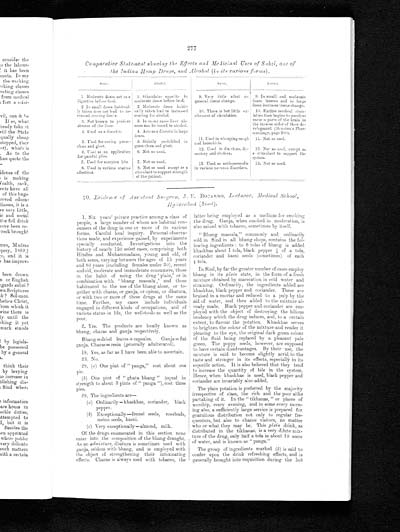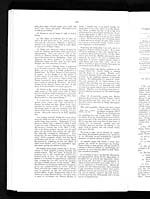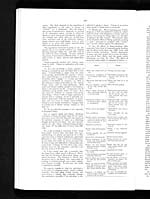Medicine - Drugs > Report of the Indian Hemp Drugs Commission, 1894-1895 > Volume VII > Evidence of Sind witnesses
(295) Page 277
Download files
Individual page:
Thumbnail gallery: Grid view | List view

277
Comparative Statement showing the Effects and Medicinal Uses of Subzi, one of
the Indian Hemp Drugs, and Alcohol (in its various forms).
| Subzi. | Alcohol. | Subzi. | Alcohol. |
| 1. Moderate doses act as a digestive before food. |
1. Stimulates appetite in moderate doses before food. |
9. Very little effect on general tissue change. |
9. In small and moderate doses lessens and in large doses increases tissue change. |
| 2 In small doses habitual- ly taken does not lead to in- creased craving desire. |
2. Moderate doses habit- ually taken lead to increased craving for alcohol. |
10. There is but little ex- citement of circulation. |
10. Excites cerebral circu- lation then begins to paralyse various parts of the brain in the inverse order of their de- velopment (Brunton's Phar- macology, page 200). |
| 3. Not known to produce abscess of the liver. |
3. In many cases liver ab- scess can be traced to alcohol. |
||
| 4. Used as a diuretic. | 4. Acts as a diuretic in large doses. |
||
| 5. Used for curing gonor- rhœa and gleet. |
5. Strictly prohibited in gonorrhœa and gleet. |
11. Used in whooping cough and bronchitis. |
11. Not so used. |
| 6. Used as an application for painful piles. |
6. Not so used. | 12. Used in diarrhœa, dy- sentery and cholera. |
l2. Not so used, except as a stimulant to support the system. |
| 7.Used for scorpion bite | 7.Not so used. | 13. Used as antispasmodic in various nervous disorders. |
13. Not so used. |
| 8. Used in various uterine affections. |
8. Not so used except as a stimulant to support strength of the patient. |
20. Evidence of Assistant Surgeon, J. E. BOCARRO, Lecturer, Medical School,
Hyderabad (Sind).
1.Six years' private practice among a class of
people, a large number of whom are habitual con-
sumers of the drug in one or more of its various
forms. Careful local inquiry. Personal observa-
tions made, and experience gained, by experiments
specially conducted. Investigations into the
history of nearly 150 select cases, comprising both
Hindus and Muhammadans, young and old, of
both sexes, varying between the ages of 15 years
and 80 years (excluding females under 30), recent
and old, moderate and immoderate consumers, those
in the habit of using the drug 'plain,' or in
combination with 'bhang massala¸' and those
habituated to the use of the bhang alone, or to-
gether with charas, or ganja, or opium, or dhatura,
or with two or more of these drugs at the same
time. Further, my cases include individuals
engaged in different kinds of occupations, and of
various status in life, the well-to-do as well as the
poor.
2. Yes. The products are locally known as
bhang, charas and ganja respectively.
Bhang = dried leaves+capsules. Ganja = flat
ganja. Charas=resin (generally adulterated).
19. Yes, as far as I have been able to ascertain.
23. No.
28.(a)One pint of "panga," cost about one
pie.
(b) One pint of "ghata bhang" (equal in
strength to about 3 pints of "panga"), cost three
pies.
29. The ingredients are—
(a) Ordinarily—khaskhas, coriander, black
pepper.
(b) Exceptionally—fennel seeds, rosebuds,
melon seeds, kasni.
(c)Very exceptionally—almond, milk.
Of the drugs enumerated in this section none
enter into the composition of the bhang draught.
As an admixture, dhatura is sometimes used with
ganja, seldom with bhang, and is employed with
the object of strengthening their intoxicating
effects. Charas is always used with tobacco, the
latter being employed as a medium for smoking
the drug. Ganja, when smoked in moderation, is
also mixed with tobacco, sometimes by itself.
"Bhang massala," commonly and ordinarily
sold in Sind in all bhang shops, contains the fol-
lowing ingredients: to 6 tolas of bhang is added
khaskhas about 1 tola, black pepper 1/6 of a tola,
coriander and kasni seeds (sometimes) of each
½ tola.
In Sind, by far the greater number of cases employ
bhang in its plain state, in the form of a fresh
mixture obtained by maceration in cold water and
straining. Ordinarily, the ingredients added are
khaskhas, black pepper and coriander. These are
bruised in a mortar and reduced to a pulp by the
aid of water, and then added to the mixture al-
ready made. Black pepper and coriander are em-
ployed with the object of destroying the bilious
tendency which the drug induces, and, to a certain
extent, to flavour the potation. Khaskhas serves
to brighten the colour of the mixture and render it
pleasing to the eye, the original dark green colour
of the fluid being replaced by a pleasant pale
green. The poppy seeds, however, are supposed
to have certain disadvantages. By their use, the
mixture is said to become slightly acrid to the
taste and stronger in its effects, especially in its
soporific action. It is also believed that they tend
to increase the quantity of bile in the system.
Hence, when khaskhas is used, black pepper and
coriander are invariably also added.
The plain potation is preferred by the majority
irrespective of class, the rich and the poor alike
partaking of it. In the "tikhanas," or places of
worship, every evening, and in some every morn-
ing also, a sufficiently large service is prepared for
gratuitous distribution not only to regular fre-
quenters, but also to chance visitors, no matter
who or what they may be. This plain drink, as
distributed in the tikhanas, is a very dilute mix-
ture of the drug, only half a tola in about 10 seers
of water, and is known as "panga."
The group of ingredients marked (b) is said to
confer upon the drink refreshing effects, and is
generally brought into requisition during the hot
Set display mode to: Large image | Zoom image | Transcription
Images and transcriptions on this page, including medium image downloads, may be used under the Creative Commons Attribution 4.0 International Licence unless otherwise stated. ![]()
| India Papers > Medicine - Drugs > Report of the Indian Hemp Drugs Commission, 1894-1895 > Volume VII > Evidence of Sind witnesses > (295) Page 277 |
|---|
| Permanent URL | https://digital.nls.uk/74911470 |
|---|




